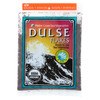Maine Coast
Maine Coast Organic Sea Vegetables - Dulse - Flakes - 4 oz
- UPC:
- 034529123650
- Minimum Purchase:
- 2 units
- Shipping:
- $0.99 (Fixed Shipping Cost)
Description
Maine Coast Sea Vegetables Wild Atlantic Dulse are hand-harvested from remote Gulf of Maine bays at the peak of nutrition and taste (early summer to early fall.) All of their Dulse products undergo annual OCIA organic inspection for handling and harvesting, as well as voluntary testing for heavy metal, chemical and microbiological contaminants.
- Delicious as a healthy snack. Low temperature sun dried, enzyme active.
- Excellent source of Iodine and Vitamin B6.
- Good source of Potassium and Iron.
- More total dietary fiber (33%) and soluble fiber (16%) than oat bran.
- Tested for chemical, heavy metal, and bacteriological pollution.
- Meets all OCIA Organic Standards for sustainable harvesting and handling.
Ingredients: Low temperature dried Dulse
Dried seaweed is a nutritional powerhouse. Sea vegetables provide all 56 minerals and trace elements required for your body's physiological functions, some in quantities greatly exceeding those of land plants. They contain significant levels of vitamins, including the B vitamins, Vitamin A, and Vitamin C. Their protein content ranges from 10% to almost 40%, and they contain all or most of the essential amino acids required by humans. They’re low in fat and high in fiber; two qualities that make them healthy for the heart. And then, of course, there’s iodine. Sea vegetables are one of the highest natural sources of dietary iodine, even when eaten in small quantities.
Below are two tables showing levels of selected nutrients found in our eight species of whole leaf sea vegetable, seaweed blends, and in Kelp Krunch. Milled sea vegetables have the same nutritional composition as the whole leaf from which they were milled. For example, dulse flakes have the same nutritional composition as whole leaf dulse. The levels in these tables are provided as “amounts per 100g” because this is how the information is normally presented for food industry specifications. It also makes it easier to compare levels between species and products. You can use this table to calculate how much of any specific nutrient you're getting in a specific serving size. All you need is a calculator and a simple formula: divide the level of the nutrient found in the nutrients per 100g table by 100 to get the level per gram, and then multiply by the number of grams in your serving. Just remember, it's impossible to know the exact level of any nutrient in sea vegetables because nutrients vary between season, age, location, and other factors. Also, 100 grams is not a serving size! Serving sizes of sea vegetables are much smaller than that. If you scroll down the page past the tables you will find more information on serving size, as well as on specific nutrients.
The levels provided in these tables represent average compositions determined through various published research articles and our own testing. For some species there’s no published data for certain nutrients and we have not yet tested for those nutrients. When that’s the case, it’s indicated by “ND” (No Data). Also, it’s important to keep in mind that sea vegetables are wild marine plants, and their nutritional composition is known to vary due to naturally occurring fluctuations in the plants. These fluctuations may be due to location, season, tidal flows, ocean temperatures, weather patterns, and other factors. The values presented here are not absolutes, and we believe the whole plants provide more than the sum of their parts.


Serving Size
To paraphrase an old saying, oftentimes good things come in small portions. This is definitely true of sea vegetables. You don’t have to eat a lot to get the most of their flavor and nutrition. Even in Japan, where about one-third of the adult population eats seaweed almost every day, the average daily intake is only about 4-7 grams, usually over the course of 2-3 small servings eaten throughout the day. In the US, the FDA defines a serving size as the amount of food customarily consumed (i.e., typically eaten) in one sitting for that food. The FDA often refers to serving size as the “Reference Amount Customarily Consumed”, or RACC. The serving size is required information on nutrition facts labeling because it informs consumers about the nutritional value of their food in a quantifiable fashion. The serving size shouldn’t be interpreted as the amount one is supposed to eat, but rather as the amount that most people ordinarily eat. For dried edible seaweed, the FDA considers 5g to be the RACC.
The below table shows the serving size for most Maine Coast Sea Vegetable products, along with levels of the three essential minerals required on the nutrition label, plus iodine (nutritional values are rounded to nearest whole number). You’ll see that the serving size for some of our milled products is smaller than the FDA RACC of 5 grams for seaweed, whereas for whole leaf products it’s larger. We’ve learned through experience and from our customers that how much people eat very much depends on the product form and how it’s used. Sea vegetable flakes, granules and powders are usually used in small amounts to add flavor and nutrition to such things as soups, dips, or smoothies. Whole leaf sea vegetables, on the other hand, may be eaten as snacks or used as ingredients in salads or casseroles, much as one might add arugula or other greens to a mixed salad, or spinach to a lasagna.
Typical Serving Sizes For Seaweed Showing Essential Minerals and Iodine Per Serving

Size: 4 Oz
Pack of: 1
Product selling unit: Each
Additional Information
Specialty: |
100% Organic |
Suggested Use: |
If uncooked dulse is too chewy, allow it to absorb some ambient moisture (steam kettle, damp towel, humid room) and in a few days it will be tenderized by its own live enzymes. Rinsing the dulse briefly will tenderize it and make it taste less strong |
(Continued): |
Try pan frying some leaves in a well oiled skillet until they turn brownish and crisp or you can dry roast dulse pieces in a medium hot skillet or low oven until the leaves turn greenish-not black (burned!) Crumble them on grains, soups, pasta, etc. |
Disclaimer: |
We strive to provide you as much information as possible on all products we sell on our website however, to ensure your safety we urge that you read all product labels including ingredients, directions and warnings before use. |













